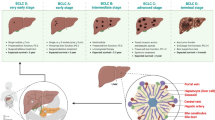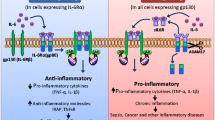Summary
The modulation of intracellular nuclear factor-kappaB (NF-κB) signaling pathway involved in the deregulated expression of cell proliferation and cell cycle regulatory molecules is a pragmatic approach for chemoprevention. Eugenol (4-allyl-1-hydroxy-2-methoxybenzene), a natural phenolic constituent of oils of cloves is known to possess attractive remedial features. In the present study, we investigated the modulatory effects of eugenol on NF-κB signaling in a rat model of gastric carcinogenesis induced by N-methyl-N′-nitro-N-nitrosoguanidine (MNNG) by analysing the expression of nuclear factor-kappaB (NF-κB) family members ((NF-κB (p50 and p65), inhibitor of kappaB alpha (IκBα), phosphorylated IκBα (p-IκBα), IκB kinase β (IKKβ)) and the NF-κB target genes that promote (e.g., cyclin D1, cyclin B and PCNA) or inhibit (e.g., p53, p21, and Gadd45) cell proliferation and cell survival. MNNG-induced gastric tumours were characterized by NF-κB activation that correlated with upregulation of IKKβ, and phosphorylation and degradation of IκBα. Furthermore, upregulation of cyclins and PCNA with downregulation of p21, p53, and Gadd45 suggested that the proliferative advantage in gastric carcinomas is dependent on elevated constitutive NF-κB activity. Administration of eugenol significantly reduced the incidence of MNNG-induced gastric tumours by suppressing NF-κB activation and modulating the expression of NF-κB target genes that regulate cell proliferation and cell survival. The targeting of NF-κB signaling pathway by eugenol may have a significant impact on chemopreventive and therapeutic approaches for cancer.




Similar content being viewed by others
References
Shen HM, Tergaonkar V (2009) NF-κB signaling in carcinogenesis and as a potential molecular target for cancer therapy. Apoptosis 14:348–363
Sethi G, Sung B, Aggarwal BB (2008) Nuclear factor-kappaB activation: from bench to bedside. Exp Biol Med (Maywood) 233:21–31
Hayden MS, Ghosh S (2008) Shared principles in NF-kappaB signaling. Cell 132:344–362
Kojima M, Morisaki T, Sasaki N et al (2004) Increased nuclear factor-kB activation in human colorectal carcinoma and its correlation with tumor progression. Anticancer Res 24:675–681
Nakayama H, Ikebe T, Beppu M et al (2001) High expression levels of nuclear factor kappaB, IkappaB kinase alpha and Akt kinase in squamous cell carcinoma of the oral cavity. Cancer 92:3037–3044
Barré B, Perkins ND (2007) A cell cycle regulatory network controlling NF-kappaB subunit activity and function. EMBO J 26:4841–4855
Tergaonkar V, Pando M, Vafa O et al (2002) p53 stabilization is decreased upon NFκB activation: a role for NFκB in acquisition of resistance to chemotherapy. Cancer Cell 1:493–503
Ho L, Davis RE, Conne B et al (2005) MALT1 and the API2-MALT1 fusion act between CD40 and IKK and confer NF-κB-dependent proliferative advantage and resistance against FAS-induced cell death in B cells. Blood 105:2891–2899
Vairapandi M, Balliet AG, Hoffman B et al (1996) The differentiation primary response gene MyD118, related to GADD45, encodes for a nuclear protein, which interacts with PCNA and p21WAF1/CIP1. Oncogene 12:2579–2594
Aggarwal BB, Shishodia S, Takada Y et al (2005) Curcumin suppresses the paclitaxel-induced nuclear factor-kappaB pathway in breast cancer cells and inhibits lung metastasis of human breast cancer in nude mice. Clin Cancer Res 11:7490–7498
Bhardwaj A, Sethi G, Vadhan-Raj S et al (2007) Resveratrol inhibits proliferation, induces apoptosis, and overcomes chemoresistance through down-regulation of STAT3 and nuclear factor kappaB-regulated antiapoptotic and cell survival gene products in human multiple myeloma cells. Blood 109:2293–2302
Letchoumy PV, Mohan KV, Prathiba D et al (2007) Comparative evaluation of antiproliferative, antiangiogenic and apoptosis inducing potential of black tea polyphenols in the hamster buccal pouch carcinogenesis model. J Carcinog 6:19
Kunnumakkara AB, Diagaradjane P, Guha S et al (2008) Curcumin sensitizes human colorectal cancer xenografts in nude mice to gamma-radiation by targeting nuclear factor-kappaBregulated gene products. Clin Cancer Res 14:2128–2136
Sweeney CJ, Mehrotra S, Sadaria MR et al (2005) The sesquiterpene lactone parthenolide in combination with docetaxel reduces metastasis and improves survival in a xenograft model of breast cancer. Mol Cancer Ther 4:1004–1012
Sarkar FH, Li Y (2008) NF-kappaB a potential target for cancer chemoprevention and therapy. Front Biosci 13:2950–2959
Van Waes C (2007) Nuclear factor-kappaB in development, prevention, and therapy of cancer. Clin Cancer Res 13:1076–1082
Yukio M, Masao S, Shigemasa H et al (2003) Preventive effect of bis-eugenol, a eugenol ortho dimer, on lipopolysaccharide-stimulated nuclear factor kappa B activation and inflammatory cytokine expression in macrophages. Biochem Pharmacol 66:1061–1066
Ghosh R, Nadiminty N, Fitzpatrick JE et al (2005) Eugenol causes melanoma growth suppression through inhibition of E2F1 transcriptional activity. J Biol Chem 28:5812–5819
Pisano M, Pagnan G, Loi M et al (2007) Antiproliferative and pro-apoptotic activity of eugenol-related biphenyls on malignant melanoma cells. Mol Cancer 6:8
Saravanan K, Nagarajan B (1993) Genotoxicity assessment in vivo in gastric carcinogenesis. Med Sci Res 21:119–121
Chandra Mohan KVP, Devaraj H, Prathiba D, Hara Y, Nagini S (2006) Antiproliferative and apoptosis inducing effect of lactoferrin and black tea polyphenol combination on hamster buccal pouch carcinogenesis. Biochim Biophys Acta 1760:1536–1544
Nagini S, Vidjaya Letchoumy P, Thangavelu A et al (2009) Of humans and hamsters: A comparative evaluation of carcinogen activation, DNA damage, cell proliferation, apoptosis, invasion, and angiogenesis in oral cancer patients and hamster buccal pouch carcinomas. Oral Oncol 45:e31–e37
Azuine MA, Amonkar AJ, Bhide SV (1991) Chemopreventive efficacy of betel leaf extract and its constituents on 7, 12-dimethylbenz(a)anthracene induced carcinogenesis and their effect on drug detoxification system in mouse skin. Indian J Exp Biol 29:346–351
Sukumaran K, Unnikrishnan MC, Kuttan R (1994) Inhibition of tumour promotion in mice by eugenol. Indian J Physiol Pharmacol 38:306–308
Alao JD (2007) The regulation of cyclin D1 degradation: roles in cancer development and the potential for therapeutic invention. Mol Cancer 6:24
Stoimenov L, Helleday T (2009) PCNA on the crossroad of cancer. Biochem Soc Trans 37:605–613
Abbas T, Dutta A (2009) p21 in cancer: intricate networks and multiple activities. Nat Rev Cancer 9:400–414
Fuster JJ, Sanz-Gonzalez SM, Moll UM et al (2007) Classic and novel roles of p53: prospects for anticancer therapy. Trends Mol Med 13:192–199
Cretu A, Sha X, Tront J et al (2009) Stress sensor Gadd45 gene as therapeutic targets in cancer. Cancer Ther 7:268–276
Harish Kumar G, Vidya Priyadarsini R, Vinothini G et al (2009) The neem limonoids azadirachtin and nimbolide inhibits cell proliferation and induce apoptosis in an animal model of oral oncogenesis. Invest New Drugs (in press)
Horta MC, de Assis LA, de Souza AF et al (2007) p53 and p21WAF1/CIP1 overexpression at the invasive front of lower lip squamous cell carcinoma. J Oral Pathol Med 36:88–92
Jang TJ, Kang MS, Kim H et al (2000) Increased expression of cyclin D1, cyclin E and p21(CIP1) associated with decreased expression of p27(KIP1) in chemically induced rat mammary carcinogenesis. Jpn J Cancer Res 91:1222–1232
Acknowledgements
Financial support from the Indian Council of Medical Research, New Delhi, India in the form of a Senior Research Fellowship to Mr. P. Manikandan is gratefully acknowledged.
Author information
Authors and Affiliations
Corresponding author
Rights and permissions
About this article
Cite this article
Manikandan, P., Vinothini, G., Vidya Priyadarsini, R. et al. Eugenol inhibits cell proliferation via NF-κB suppression in a rat model of gastric carcinogenesis induced by MNNG. Invest New Drugs 29, 110–117 (2011). https://doi.org/10.1007/s10637-009-9345-2
Received:
Accepted:
Published:
Issue Date:
DOI: https://doi.org/10.1007/s10637-009-9345-2




